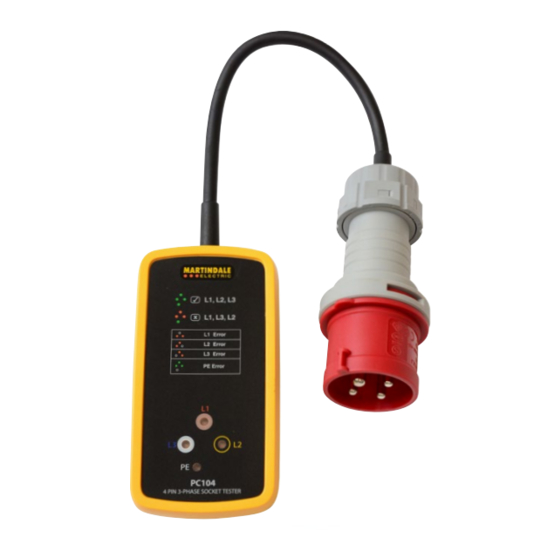
Table of Contents
Advertisement
Quick Links
Advertisement
Table of Contents

Summary of Contents for Martindale Electric PC104-2
- Page 1 PC104-2 & PC105-2 3-PHASE SOCKET TESTER Instruction Manual...
-
Page 2: Table Of Contents
ALWAYS READ THESE INSTRUCTIONS BEFORE PROCEEDING Thank you for buying one of our products. For safety and full understanding of its benefits please read this manual before use. Technical support is available from 01923 441717 and support@martindale-electric.co.uk. CONTENTS Safety Information Meaning of Symbols and Markings Precautions Introduction... -
Page 3: Safety Information
1. SAFETY INFORMATION: Always read before proceeding. REMEMBER: SAFETY IS NO ACCIDENT These instructions contain both information and warnings that are necessary for the safe operation and maintenance of this product. It is recommended that you read the instructions carefully and ensure that the contents are fully understood. -
Page 4: Precautions
1.2 Precautions This product has been designed with your safety in mind, but please pay attention to the following warnings and cautions before use. Warning In order to avoid the danger of electrical shock, it is important that proper safety measures are taken when working with voltages exceeding 30V AC rms, 42V AC peak or 60V DC. - Page 5 If the equipment is used in a manner not specified by the manufacturer, the protection provided by the equipment may be impaired. Test equipment should be secured when not in use to prevent use by unauthorised persons. In particular, keep out of reach of children. Caution Avoid severe mechanical shock or vibration and extreme temperature.
-
Page 6: Introduction
2 INTRODUCTION 2.1 Inspection Examine the shipping carton for any sign of damage. Inspect the unit and any accessories for damage. If there is any damage then consult your distributor immediately. 2.2 Description The PC104 & PC105 are 3-phase socket testers intended to check CEE 4 &... -
Page 7: Operation
3. OPERATION 3.1 Testing a 3-Phase Socket Plug the PC104 or PC105 into the socket to be tested and refer to the table below, or the front decal of the unit, to determine the wiring condition of the socket under test. PC104 PC105 Wiring Condition... -
Page 8: Wiring Colour Coding
The PC104 & PC105 also indicates the wiring condition by sounding a buzzer according to the table below: Condition Buzzer Indication Correct socket wiring, phase sequence Continuous tone correct Phases wired incorrectly, phase Slow intermittent tone sequence incorrect Phase, PE or neutral missing Fast intermittent tone Note: The interchanging of the neutral wire (N) with the earth (PE) cannot be recognised by this device. -
Page 9: Maintenance
4. MAINTENANCE 4.1 Cleaning Warning To reduce the risk of surface leakage, this instrument must be kept in a clean condition. Warning Prior to cleaning, ensure that the instrument is disconnected from any voltage source. If contamination is found, clean with a damp soft cloth and if necessary a mild detergent. -
Page 10: Warranty
5. WARRANTY AND LIMITATION OF LIABILITY This Martindale product is warranted to be free from defects in material and workmanship under normal use and service. The warranty period is 2 years and begins on the date of receipt by the end user. -
Page 11: Specifications
Specification PC104 & PC105 3-Phase Socket Tester ELECTRICAL SPECIFICATIONS Input voltage range: 200V to 440V AC (Phase to Phase) Un = 400V (+/-10%) Input frequency: 50Hz or 60Hz Input current: I LI = I L2 = I L3 = 15mA max GENERAL SPECIFICATIONS Power: From circuit under test Dimensions: 152(L) x 81(W) x 35(D) mm... - Page 12 Ver. C1.1 Due to policy of continuous development, Martindale Electric reserves the right to alter equipment specification and description outlined in this document without prior notice. No part of this document shall be deemed to be part of any contract for the equipment unless specifically referred to as an inclusion within such contract.
















Need help?
Do you have a question about the PC104-2 and is the answer not in the manual?
Questions and answers